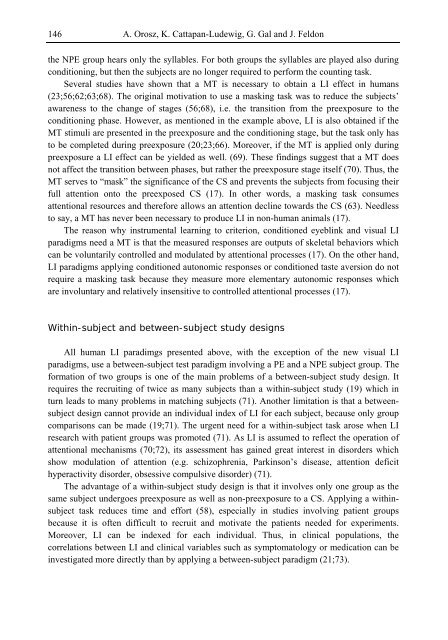Schizophrenia Research Trends
Schizophrenia Research Trends
Schizophrenia Research Trends
- No tags were found...
Create successful ePaper yourself
Turn your PDF publications into a flip-book with our unique Google optimized e-Paper software.
146A. Orosz, K. Cattapan-Ludewig, G. Gal and J. Feldonthe NPE group hears only the syllables. For both groups the syllables are played also duringconditioning, but then the subjects are no longer required to perform the counting task.Several studies have shown that a MT is necessary to obtain a LI effect in humans(23;56;62;63;68). The original motivation to use a masking task was to reduce the subjects’awareness to the change of stages (56;68), i.e. the transition from the preexposure to theconditioning phase. However, as mentioned in the example above, LI is also obtained if theMT stimuli are presented in the preexposure and the conditioning stage, but the task only hasto be completed during preexposure (20;23;66). Moreover, if the MT is applied only duringpreexposure a LI effect can be yielded as well. (69). These findings suggest that a MT doesnot affect the transition between phases, but rather the preexposure stage itself (70). Thus, theMT serves to “mask” the significance of the CS and prevents the subjects from focusing theirfull attention onto the preexposed CS (17). In other words, a masking task consumesattentional resources and therefore allows an attention decline towards the CS (63). Needlessto say, a MT has never been necessary to produce LI in non-human animals (17).The reason why instrumental learning to criterion, conditioned eyeblink and visual LIparadigms need a MT is that the measured responses are outputs of skeletal behaviors whichcan be voluntarily controlled and modulated by attentional processes (17). On the other hand,LI paradigms applying conditioned autonomic responses or conditioned taste aversion do notrequire a masking task because they measure more elementary autonomic responses whichare involuntary and relatively insensitive to controlled attentional processes (17).Within-subject and between-subject study designsAll human LI paradimgs presented above, with the exception of the new visual LIparadigms, use a between-subject test paradigm involving a PE and a NPE subject group. Theformation of two groups is one of the main problems of a between-subject study design. Itrequires the recruiting of twice as many subjects than a within-subject study (19) which inturn leads to many problems in matching subjects (71). Another limitation is that a betweensubjectdesign cannot provide an individual index of LI for each subject, because only groupcomparisons can be made (19;71). The urgent need for a within-subject task arose when LIresearch with patient groups was promoted (71). As LI is assumed to reflect the operation ofattentional mechanisms (70;72), its assessment has gained great interest in disorders whichshow modulation of attention (e.g. schizophrenia, Parkinson’s disease, attention deficithyperactivity disorder, obsessive compulsive disorder) (71).The advantage of a within-subject study design is that it involves only one group as thesame subject undergoes preexposure as well as non-preexposure to a CS. Applying a withinsubjecttask reduces time and effort (58), especially in studies involving patient groupsbecause it is often difficult to recruit and motivate the patients needed for experiments.Moreover, LI can be indexed for each individual. Thus, in clinical populations, thecorrelations between LI and clinical variables such as symptomatology or medication can beinvestigated more directly than by applying a between-subject paradigm (21;73).
















